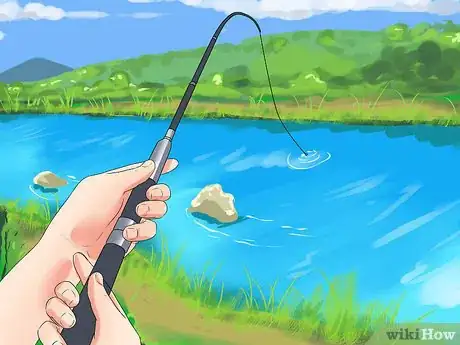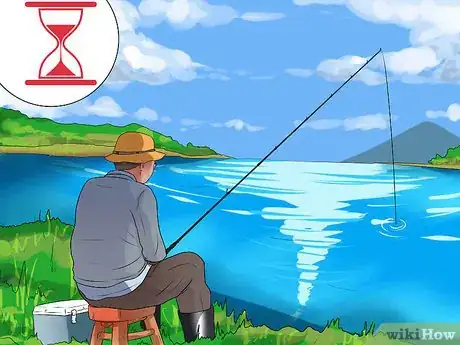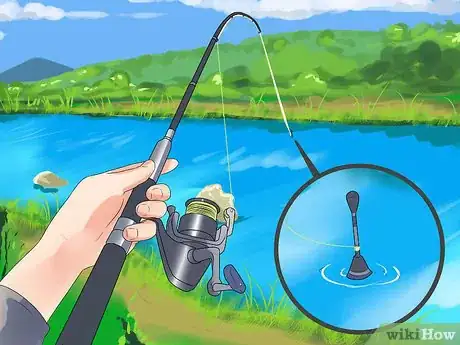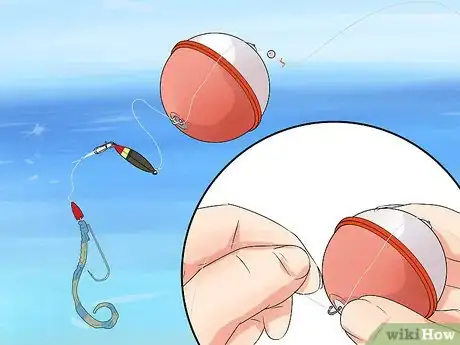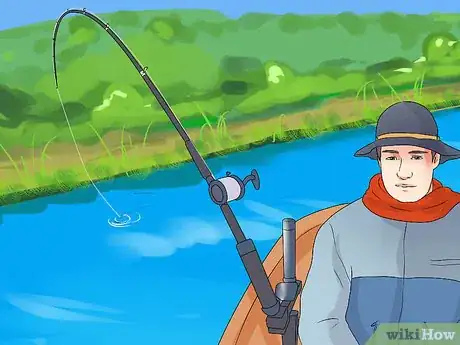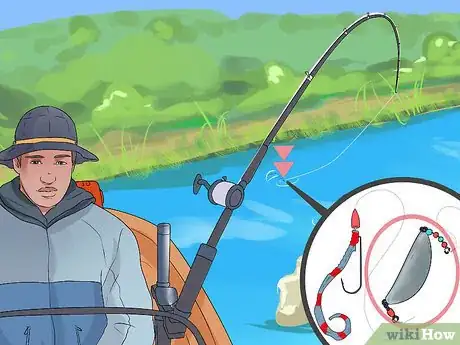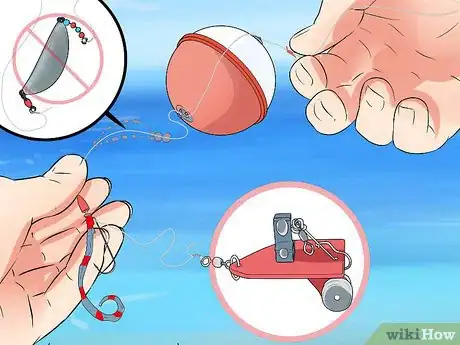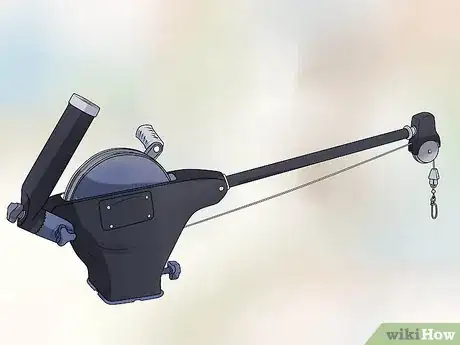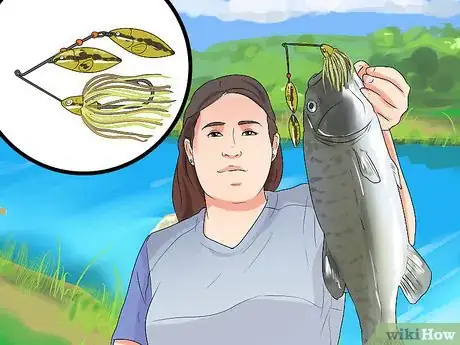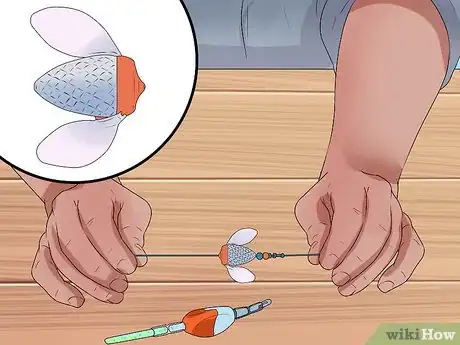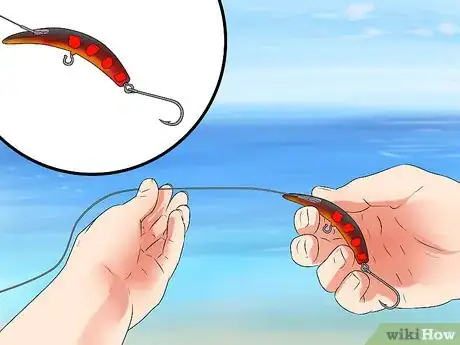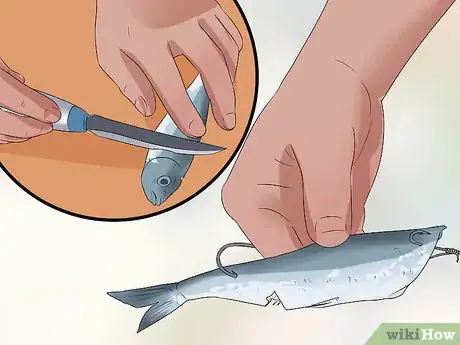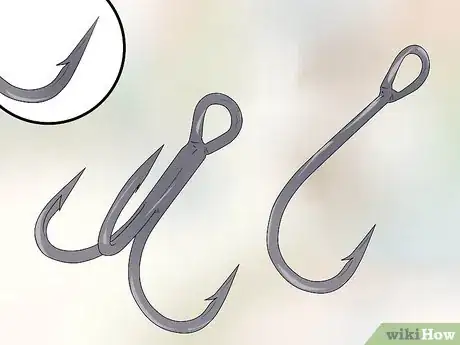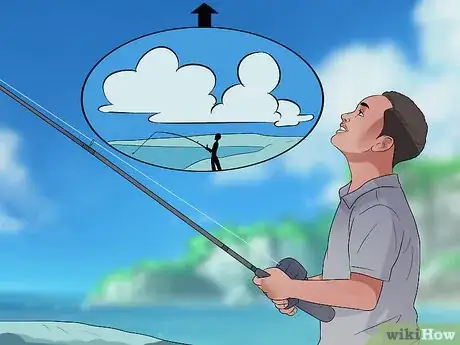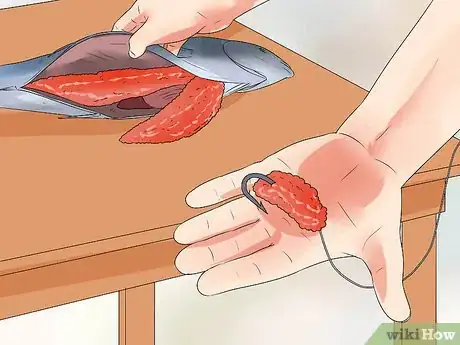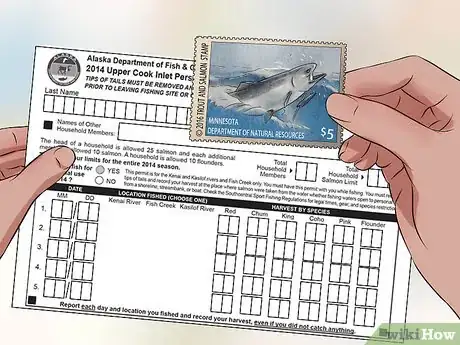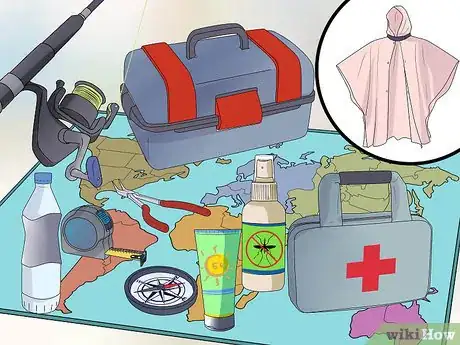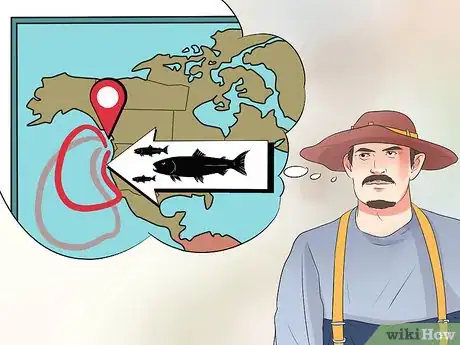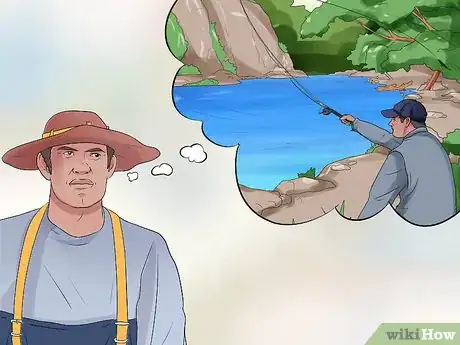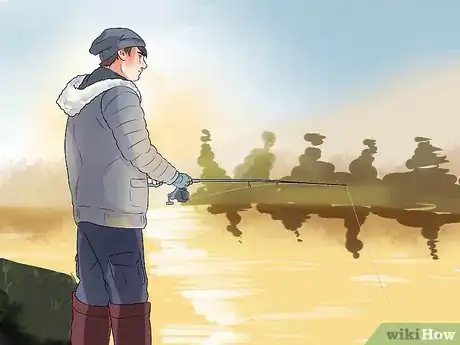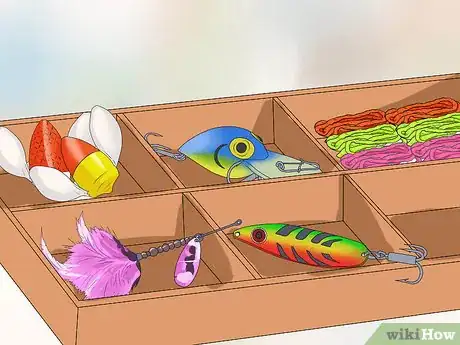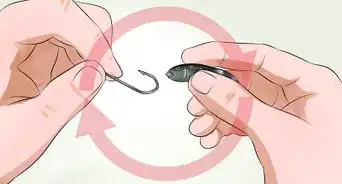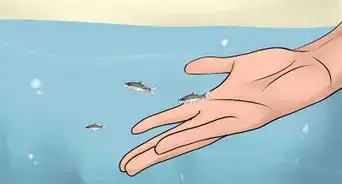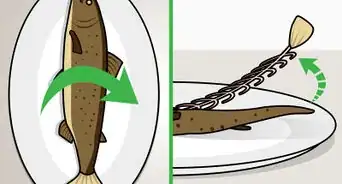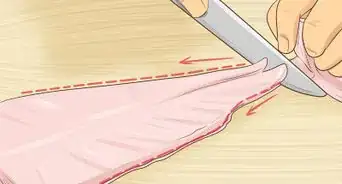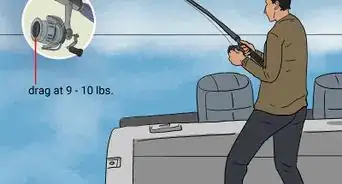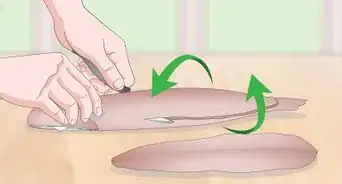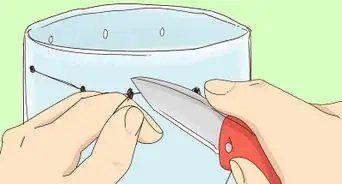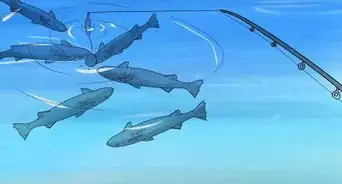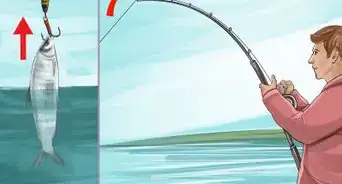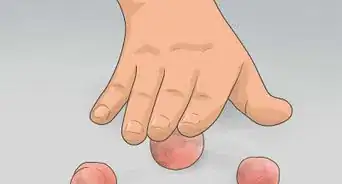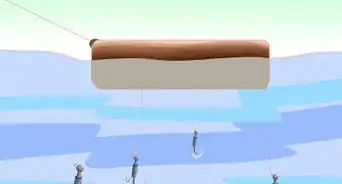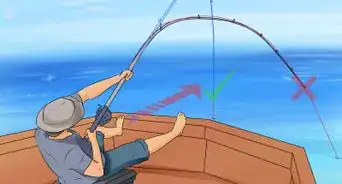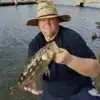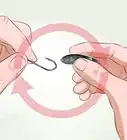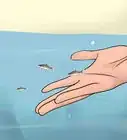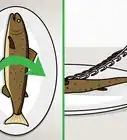This article was co-authored by Michael Reynolds. Michael Reynolds is a Professional Fishing Instructor and the Owner of Long Beach, California Fishing Lessons by Michael Reynolds. In his over 40 years of fishing experience, Michael has become very knowledgeable about the variety of fishing methods and techniques. He is passionate about sharing his knowledge with beginners to experienced anglers. Michael has been guiding and teaching fishing for over five years and is licensed and bonded with the Department of Fish and Wildlife (DFW).
There are 18 references cited in this article, which can be found at the bottom of the page.
wikiHow marks an article as reader-approved once it receives enough positive feedback. In this case, 100% of readers who voted found the article helpful, earning it our reader-approved status.
This article has been viewed 197,558 times.
Salmon is a popular fish due to its versatile taste and nutritional value.[1] And what could be better than eating such a healthy meal fresh from the stream? Fishermen have long made use of the migratory habits, and the challenge of catching this fast, powerful fish is enjoyable in its own right. To give yourself the best opportunity to catch salmon, you'll need patience, the right gear, and knowledge of the habits of salmon.
Steps
Learning Salmon Fishing Techniques
-
1Try your hand at drift fishing. This method is frequently utilized by angler fishers, who will cast a line from a stationary spot and allow it to drift. As the line drifts, the angler slowly reels in his line to get ready to repeat the process. This kind of fishing is most commonly done in a river with a current upon which your bait can drift.[2]
- Cast your line and bait at 30 - 45° upriver and allow your it to ride the current of the river. When your bait reaches an angle of approximately 30 - 45°, you should reel in your line and prepare to cast again.
- You should weight your fishing setup so that it bounces along the bottom of the river touching at intervals of about a foot.
- Generally, you should equip yourself with an 8½ - 9 foot rod.
- You should fish for Chinook salmon 20 - 25 lb line.
- Pink salmon can be effectively fished for with a 10 - 15 lb line.[3]
-
2Practice the art of plunking. This style is comparable to drift fishing, with the exception that instead of casting your line over a wide swatch of river, you instead cast into a migratory path or area known to hold salmon. Once your gear is cast, you should wait for the fish to strike, or reel in your line to change your setup.[4]
- Your mainline should be rated between 40 - 60 lbs and tied directly to your lure.
- Your leader will attach your weight to your setup. It should be tested for 15 lbs, and should be from 18" - 30" long. You will likely need between 1 and 8 ounces of lead to attain the best depth.[5]
Advertisement -
3Fish while you float. Float fishing, also referred to as bobber fishing, is a somewhat new fishing strategy used by American salmon fishermen. The basic rigging that you should use for your float fishing setup should include 12 lb test line, a bobber, a bobber stop, a bead (usually included with your bobber stop), a barrel swivel, and a lure.[6]
- These parts can be found at most sporting goods or fishing supply stores.
-
4Rig your bobber setup for float fishing for salmon. This requires tying your bobber to your line and then fastening your bobber stop, which must be done according to the style of bobber stop you have purchased. Some use rubber bands, others can be knotted into the mainline, but after you have affixed your stop:
- Thread the bead that came with your stop, or any other bead that fits your line without slipping over your bobber stop or being large enough to get catch your bobber.
- Slide your bobber onto the mainline, tie a size 7 barrel swivel into your line, and add weight recommended for your lure to your leader line, a thinner, 18-24 in length of line beneath your swivel.[7]
- Keep in mind that salmon prefer darker areas; you will likely want enough weight on your rig to place your lure at an appropriately dark depth.
- Float fishing is ideal for rivers small or medium in size, with moderate deepness and medium to medium-fast current.[8]
-
5Troll the water for salmon. Trolling is a kind of boat fishing where you periodically move your boat up and downstream instead of anchoring in one spot. This can be beneficial when catching salmon since salmon tend to move with the current of a river or stream rather than staying stationary. Within trolling, there are three main types of boating technique: motor mooching, diver trolling, and down rigger trolling.
-
6Discover the joy of mooching while you troll. Motor mooching is where you troll in a boat using the same kind of sinker as drift moochers, called a mooching sinker or banana sinker. Many fishermen will troll for salmon with plug cut herring lure or a small spoon similar in shape, changing the speed of the engine to vary depth, speed, and the action of the bait.[9]
-
7Use a diver on your mainline when trolling. Divers have long been a part of the fishing world. A diver is an attachment that can be added to your mainline, which causes your line to cut beneath the surface of the water as a function of your boat speed and current speed.[10]
- With a diver, there is no need for a sinker to achieve your fishing depth, and when a fish bites, its extra weight should tip the diver down allowing you to reel your catch in without resistance.
-
8Utilize a downrigger for trolling. A downrigger is a mechanical attachment that consists of a winch and weight. The weight carries your line and lure down to a specified depth, allowing you to more precisely target the optimal feeding zones of salmon. To set your downrigger:
- Reach trolling speed with your boat. Take your rod in hand and release the line to your desired depth and place your rod in the rod holder.
- Gather your line from beyond the tip of your rod in one hand and take your line release with your other hand. Take the weight of your downrigger (also called a cannonball) out of the water and attach the line to the line release.
- Return the weight to the water and take the downrigger reel handle firmly in hand. Loosen the clutch (usually found on the right side of the downrigger) to release the locking mechanism on your weight.
- Monitor the line counter (usually recorded in feet) and set it to your desired depth, tightening the clutch when you've reached your depth.
- Apply your drag clicker and reel in your line until there is a slight bowing in your rod. If you feel a fish on the line, you should take you rod from the holder and lift to activate the line release.
- Once you've reeled your catch, retrieve your weight by loosing the clutch and reeling up your downrigger crank until it surfaces.
Picking Your Lure
-
1Select spinners for success. Spinners are a kind of lure that have metal blades that spin while the lure is moving through the water. This causes the lure to catch the light, creating a flash similar to the scales of a real fish in addition to giving more realistic movement to your lure. Spinners have four basic designs:[11]
- Standard inline, where the blades of your spinner will revolve around a straight wire.
- Spinnerbaits, which have a design closer to that of an open safety pin and will come with lead molded to the lower arm and the spinning part attached to an upper arm.
- Buzzbaits have a special propeller shaped spinner to raise your bait to the surface. This is likely not an ideal lure for salmon fishing.
- Live bait spinners position the spinner in front of hooks intended for live bait, like night crawlers or minnows.[12]
-
2Corral your catch with winged bobbers. These are considered to be a staple for bank anglers.[13] In addition, these lures can add some buoyancy to your setup, which can help with snags.[14] Size zero is recommended for spring Chinook salmon, as these fish are quite large, and spin-and-glow lures are effective for boat fishing, though some fishers report having better luck with spin-and-glow lures from shore.[15]
-
3Employ Kiwi fish or Flatfish lures. These are a specific brand of lure, currently very popular among Chinook salmon fishers for sizes ranging from K14 - K16.[16] [17] Many anglers wrap Kwikfish lures with a sardine to increase effectiveness. This can be accomplished by:
- Cutting a rectangular piece of meat from a bait sardine and attaching the meat to the bottom of the lure. You should be sure that the skin of your bait goes against your lure.
- You should consider changing your wraps regularly; some veteran anglers recommend doing so approximately ever 45 minutes, though your bait should hold up, with reduced effectiveness, for as many as 3 hours.[18] [19]
-
4Fish with plug cut herring. "Plug-cut" is a kind of bait preparation that has the head sliced off. Herring, in particular the plug-cut, is considered the tried-and-true lure of preference for lower Columbia, CA, for salmon fishing, though success is also reported with whole herring.
- Some recommend you leave entrails in your plug-cut herring to give it a better scent and potency while being used as bait.[20]
Readying Your Equipment
-
1Keep your hooks keen. Because of the fact that salmon have such a thick jaw, the sharper you keep your hooks, the better your chances of getting a salmon on the line. It is recommended that you keep your hooks razor sharp for best results.[21]
- You'll need a hook sharpener to achieve best results, which you should be able to purchase at most sporting goods stores.
- Pull the hook sharpener across the point of your hook, keeping the sharpener parallel to the shank. With quick strokes to each side of the hook, your hook should be sharpened.
- Test the sharpness of your hook by drawing your hook across the nail of your thumb at 45-degrees. If the hook sticks to your nail and doesn't slide across, it is sufficiently sharp.[22]
-
2Fish in the clouds. Not up in the clouds but below them, as salmon prefer low-level light. Overcast days are going to offer the best success for your fishing efforts. Dawn and dusk are also times that salmon are quite active, and if you are fishing for salmon, these conditions might improve your final catch count.[23]
- If the sun comes out when you are out salmon fishing, don't give up hope! Since salmon prefer lower light conditions, targeting deeper, darker water, like the shadowed areas around sandbars, can still yield results.[24]
-
3Bait for the best. Live bait can also give you a strong advantage in your search for salmon, but better yet is roe (fish eggs).[25] Many sporting goods stores will sell this kind of bait cured, which will work well for you fishing endeavors.
- You can also harvest and cure your own roe, if you're feeling adventurous, or even use artificial lures. Many fishing aficionados recommend spinning lures, called "spinners."[26]
-
4Acquire your stamp or permit. You'll need a permit to fish just about anywhere, but you might not know that in addition to your permit, you'll likely need a special stamp or an additional permit to fish for salmon legally.This will protect you from being fined, and potentially having your equipment seized or incarcerated, when you are salmon fishing.
- The permit/stamp fee you pay is important not only to the continued general health of the aquatic ecosystem, but also for stocking and conservation programs.
-
5Accumulate other necessaries. Although you probably won't forget your fishing pole, you might forget something small yet important such as your fishing license. To prevent this from happening, you should make a checklist. A sample checklist might look like:
- Compass
- First aid kit
- Fishing license
- Insect repellent
- Map (of fishing location)
- Measuring tape (to check size restrictions)
- Needle nose pliers
- Pole
- Poncho (or other rain gear)
- Sun protection
- Tackle box (with extra line, fish stringers, bobbers, hooks, jigs, leaders, lures, sinkers, weights)
- Water (bottled recommended)
Going Salmon Fishing
-
1Decide on your location. Choosing the wrong stream, water system, or lake could be the difference between a great catch and no chance of catching salmon at all. Salmon follow specific "runs" when migrating. You should look up runs, hatchery locations, dams, and approximate spawning locations for best results. Some useful sights that might help you with this include:
- Maps of hatcheries and dams in the Pacific Northwest:
http://www.pbs.org/wnet/nature/salmon-running-the-gauntlet-hatcheries-and-dams-of-the-pacific-northwest-map/6561/ - Maps for inland trout and salmon:
http://www.michigan.gov/dnr/0,4570,7-153-10364_63235-211883--,00.html
- Maps of hatcheries and dams in the Pacific Northwest:
-
2Track salmon statistics. Your local natural resources or fish and wildlife office tracks salmon migration and regularly posts these numbers online for the purposes of conservation and management. Use this information as a guide or ask a local fishing veteran which way the salmon run.
-
3Check the forecast. Remember your salmon research! These fish prefer overcast days and waters close to 55 °F (13 °C). [27] If the weather is against you and you find yourself fishing in bright weather, you should choose a bright lure to fish with. Darker weather can benefit from darker lures.
-
4Know your game-plan. Maybe you plan on starting with bank fishing and then meeting up with friends to troll fish by boat later in the day. Certain lures work better for certain techniques, and you may also need specific equipment to switch up your style. It'll be difficult for you to go float fishing if you don't have a bobber!
-
5Fish at the right time of day. Expert anglers recommend fishing for salmon early in the morning, dusk, or evening hours. It's true, you can catch salmon at any time of day, but salmon are generally more active during these times.[28]
-
6Try your hand at fishing holding areas. A holding area is a spot along the migration route where salmon slow down or stop before continuing upstream. These areas are ideal to fish for salmon, because the fish will be plentiful and they will all be focused on eating instead of migrating.[29]
- Salmon are attracted to bright colors, so use lures and bait that will catch the attention of the fish and make them want to bite. Master anglers recommend red, blue, fluorescent pink and fluorescent orange as colors that will most often attract salmon.
Expert Q&A
-
QuestionWhat is the easiest way to tie a leader to the main line?
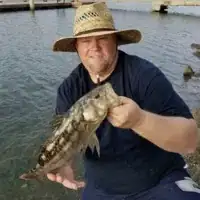 Michael ReynoldsMichael Reynolds is a Professional Fishing Instructor and the Owner of Long Beach, California Fishing Lessons by Michael Reynolds. In his over 40 years of fishing experience, Michael has become very knowledgeable about the variety of fishing methods and techniques. He is passionate about sharing his knowledge with beginners to experienced anglers. Michael has been guiding and teaching fishing for over five years and is licensed and bonded with the Department of Fish and Wildlife (DFW).
Michael ReynoldsMichael Reynolds is a Professional Fishing Instructor and the Owner of Long Beach, California Fishing Lessons by Michael Reynolds. In his over 40 years of fishing experience, Michael has become very knowledgeable about the variety of fishing methods and techniques. He is passionate about sharing his knowledge with beginners to experienced anglers. Michael has been guiding and teaching fishing for over five years and is licensed and bonded with the Department of Fish and Wildlife (DFW).
Professional Fishing Instructor The easiest way is to use a barrel swivel. Tie the main line to one eye at one end, and then tie the leader line to the other eye at the other end. Many various knots can be used, such as the Uni Knot, the Palomar Knot, the Improved Clinch Knot, and the San Diego Jam Knot.
The easiest way is to use a barrel swivel. Tie the main line to one eye at one end, and then tie the leader line to the other eye at the other end. Many various knots can be used, such as the Uni Knot, the Palomar Knot, the Improved Clinch Knot, and the San Diego Jam Knot. -
QuestionWhat is the best way to tie a swivel?
 Michael ReynoldsMichael Reynolds is a Professional Fishing Instructor and the Owner of Long Beach, California Fishing Lessons by Michael Reynolds. In his over 40 years of fishing experience, Michael has become very knowledgeable about the variety of fishing methods and techniques. He is passionate about sharing his knowledge with beginners to experienced anglers. Michael has been guiding and teaching fishing for over five years and is licensed and bonded with the Department of Fish and Wildlife (DFW).
Michael ReynoldsMichael Reynolds is a Professional Fishing Instructor and the Owner of Long Beach, California Fishing Lessons by Michael Reynolds. In his over 40 years of fishing experience, Michael has become very knowledgeable about the variety of fishing methods and techniques. He is passionate about sharing his knowledge with beginners to experienced anglers. Michael has been guiding and teaching fishing for over five years and is licensed and bonded with the Department of Fish and Wildlife (DFW).
Professional Fishing Instructor The fastest, easiest, and strongest knot to tie is the Palomar Knot, but various other knots can be used such as the Uni Knot, the Palomar Knot, the Improved Clinch Knot, and the San Diego Jam Knot.
The fastest, easiest, and strongest knot to tie is the Palomar Knot, but various other knots can be used such as the Uni Knot, the Palomar Knot, the Improved Clinch Knot, and the San Diego Jam Knot. -
QuestionHow do you unhook a fish correctly?
 Michael ReynoldsMichael Reynolds is a Professional Fishing Instructor and the Owner of Long Beach, California Fishing Lessons by Michael Reynolds. In his over 40 years of fishing experience, Michael has become very knowledgeable about the variety of fishing methods and techniques. He is passionate about sharing his knowledge with beginners to experienced anglers. Michael has been guiding and teaching fishing for over five years and is licensed and bonded with the Department of Fish and Wildlife (DFW).
Michael ReynoldsMichael Reynolds is a Professional Fishing Instructor and the Owner of Long Beach, California Fishing Lessons by Michael Reynolds. In his over 40 years of fishing experience, Michael has become very knowledgeable about the variety of fishing methods and techniques. He is passionate about sharing his knowledge with beginners to experienced anglers. Michael has been guiding and teaching fishing for over five years and is licensed and bonded with the Department of Fish and Wildlife (DFW).
Professional Fishing Instructor If the fish is hooked in the lip, simply reverse the hook out by using a pair of pliers and force. Usually, a fast twist of the wrist is the most effective way to remove a hook.
If the fish is hooked in the lip, simply reverse the hook out by using a pair of pliers and force. Usually, a fast twist of the wrist is the most effective way to remove a hook.
Warnings
- Depending on region and body of water there will be weight limits determined by state and federal fish and wildlife agencies. These will dictate how many fish per day or fishing season you are allowed to catch. Be sure you follow catch limits to avoid penalties and fines.⧼thumbs_response⧽
- Always be aware of your environment when casting your line. Sharpened hooks can be a hazard to inattentive anglers.⧼thumbs_response⧽
Things You'll Need
- Compass
- First aid kit
- Fishing license
- Insect repellent
- Map (of fishing location)
- Measuring tape (to check size restrictions)
- Needle nose pliers
- Pole
- Poncho (or other rain gear)
- Sun protection
- Tackle box (with extra line, fish stringers, bobbers, hooks, jigs, leaders, lures, sinkers, weights)
- Water (bottled recommended)
References
- ↑ http://www.bbcgoodfood.com/howto/guide/ingredient-focus-salmon
- ↑ http://www.piscatorialpursuits.com/resourcecenter/driftfishing.htm
- ↑ http://wdfw.wa.gov/fishing/salmon/howtocatch/freshwater.html
- ↑ http://www.how-to-fish.com/how_to_bank_fish_coast_rivers_for_salmon.htm
- ↑ http://wdfw.wa.gov/fishing/salmon/howtocatch/freshwater.html
- ↑ http://www.piscatorialpursuits.com/resourcecenter/floatfishing.htm
- ↑ http://www.piscatorialpursuits.com/resourcecenter/floatfishing.htm
- ↑ http://www.fishonbc.com/articles/autumn-salmon-fishing-strategies/
- ↑ http://www.how-to-fish.com/mooching_for_salmon_how_to.htm
- ↑ http://www.leeroysramblings.com/Diver_Trolling.htm
- ↑ http://www.fishingtipsdepot.com/salmon-fishing-tips/
- ↑ http://learninghowtofish.com/fishing-equiptment/fishing-spinners/
- ↑ http://www.tnscommunications.net/spring-chinook-tactics.html
- ↑ http://www.fishingmagician.com/Stories/New-to-Steelheading--Here%E2%80%99s-Some-Basics.aspx
- ↑ http://www.tnscommunications.net/spring-chinook-tactics.html
- ↑ http://wdfw.wa.gov/fishing/salmon/howtocatch/freshwater.html
- ↑ http://www.tnscommunications.net/spring-chinook-tactics.html
- ↑ http://www.ketchikanalaskafishing.com/fishing-tips-techniques/
- ↑ http://www.tnscommunications.net/spring-chinook-tactics.html
- ↑ http://www.tnscommunications.net/spring-chinook-tactics.html
- ↑ http://www.fishingtipsdepot.com/salmon-fishing-tips/
- ↑ http://howtoflyfish.orvis.com/choosing-equipment/equipment-articles/475-how-to-sharpen-a-hook
- ↑ http://www.nesportsman.com/articles/article19.shtml
- ↑ http://www.seattletimes.com/life/outdoors/salmon-fishing-on-the-columbia-river-is-as-hot-as-the-weather/
- ↑ http://www.how-to-fish.com/how_to_bank_fish_coast_rivers_for_salmon.htm
- ↑ http://www.fishingtipsdepot.com/salmon-fishing-tips/
- ↑ http://www.nesportsman.com/articles/article19.shtml
- ↑ http://www.fishingaustralia.tv/post/essentials-of-spinning-for-australian-salmon
- ↑ http://www.dec.ny.gov/outdoor/37926.html
About This Article
If you’re trying to catch salmon, start by picking a day that’s overcast, and head out at dawn or dusk, since that’s when salmon are most active. Additionally, get your hands on some live bait, such as herring or fish eggs, if you have access to a sporting goods store. Alternatively, use artificial lures to tempt the salmon, like a spinner that creates a flash that looks like the scales of a real fish. You can also try winged bobbers, which are attractive to salmon and help keep the line free from snags by adding buoyancy. To learn how to catch salmon by drift fishing, float fishing, or trolling, keep reading!
